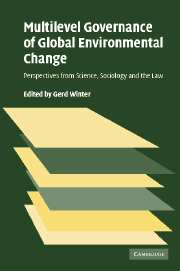 Multilevel Governance of Global Environmental Change
Multilevel Governance of Global Environmental Change Book contents
- Frontmatter
- PREFACE
- Contents
- List of figures
- List of tables
- Notes on contributors
- List of abbreviations
- 1 Introduction
- PART I Earth system analysis
- 2 Dimensions and mechanisms of global climate change
- 3 Global climate change: what can we learn from the past?
- PART II Society and institutions of global; environmental change
- PART III Self-regulation of industry and the law
- PART IV The potential of the state
- PART V The potential of world regions
- PART VI Formation and implementation of international regimes
- PART VII Improving the instruments of global governance
- PART VIII Fundamental concepts of institutionalising common concern
- Index
3 - Global climate change: what can we learn from the past?
Published online by Cambridge University Press: 04 May 2010
- Frontmatter
- PREFACE
- Contents
- List of figures
- List of tables
- Notes on contributors
- List of abbreviations
- 1 Introduction
- PART I Earth system analysis
- 2 Dimensions and mechanisms of global climate change
- 3 Global climate change: what can we learn from the past?
- PART II Society and institutions of global; environmental change
- PART III Self-regulation of industry and the law
- PART IV The potential of the state
- PART V The potential of world regions
- PART VI Formation and implementation of international regimes
- PART VII Improving the instruments of global governance
- PART VIII Fundamental concepts of institutionalising common concern
- Index
Summary
Evaluating the human effect on climate requires a good understanding of past climatic changes. We have to turn to history in order to understand the present. However, myths and misunderstandings about past climate changes abound and ill-informed or simplistic conclusions are often drawn.
Has climate not changed at all times, and much more than we are presently witnessing, so that humans cannot be blamed? Is climate change mostly controlled by the sun, with all human influence insignificant in comparison? Does CO2 really affect climate, or was it just the other way round in the past? Aren't humans responsible only for 2% of the greenhouse effect, and 98% is perfectly natural? And is the next ice age inevitably approaching?
A thorough analysis of what we know about climate history gives answers – sometimes surprising ones – to these and similar questions.
Many signs of past climate changes are clearly visible in the landscape, for example, the moraines of glaciers long gone (Figure 3.1). Most of our knowledge on past climate changes, however, is the result of painstaking detective work with increasingly sophisticated methods. Wherever lasting deposits form – be it sediments on the seafloor, snow layers on glaciers, stalagtites in caves, or growth rings in trees and corals – scientists will find a way to derive climatic information from these.
- Type
- Chapter
- Information
- Multilevel Governance of Global Environmental ChangePerspectives from Science, Sociology and the Law, pp. 67 - 76Publisher: Cambridge University PressPrint publication year: 2006


